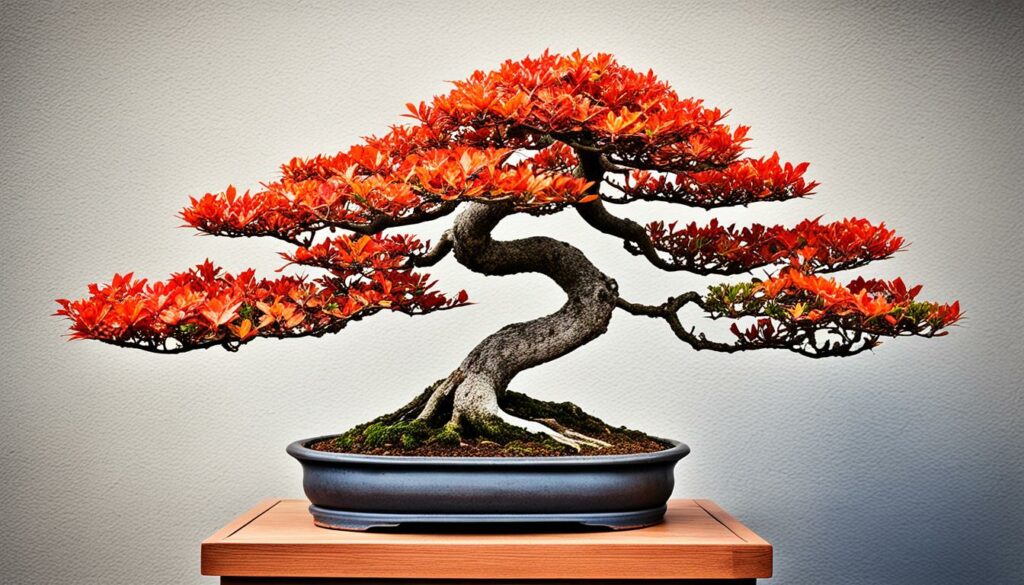Welcome to our guide on the Flame Tree bonsai, a stunning variety of tropical bonsai known for its fiery-hued foliage. The Flame Tree bonsai, scientifically named Delonix regia, belongs to the Bonsai tree species and is a stand-out choice for bonsai enthusiasts due to its vibrant and colorful blooms.
In this article, we will explore the characteristics, care techniques, and styling tips specific to the Flame Tree bonsai. We’ll discuss how to select a healthy specimen, nurture and maintain its health, shape it into an artistic masterpiece, and address common issues that bonsai enthusiasts may face. By the end of this guide, you’ll have all the knowledge you need to grow your Flame Tree bonsai into a captivating addition to your bonsai collection.
Key Takeaways:
- Flame Tree bonsai is a popular variety of the Bonsai tree species and is known for its colorful foliage.
- The Flame Tree bonsai is a tropical species -its scientific name is Delonix regia.
- Choosing a healthy specimen is crucial to ensure proper growth and longevity.
- Proper maintenance techniques such as watering, fertilizing, pruning, and wiring are essential for ensuring the health of your bonsai.
- Styling and shaping your Flame Tree Bonsai is a key step in creating a visually striking masterpiece that showcases its unique character.
Understanding the Flame Tree Bonsai
If you are new to the world of bonsai, you may be wondering what makes the Flame Tree bonsai such a popular choice among enthusiasts. Scientifically known as Delonix regia, this tropical species is native to Madagascar and other parts of Africa and has been widely cultivated for its stunning foliage and brilliant flowers.
The Flame Tree bonsai is best known for its bright orange-red flowers that bloom in clusters. These blooms can last for several months, adding a burst of color to your bonsai collection. The foliage is equally striking with vibrant green leaves that can transform into brilliant shades of yellow and orange during the fall months.
To cultivate a Flame Tree bonsai, it’s important to understand its tropical origins. This species requires warm temperatures, plenty of sunlight, and ample moisture to thrive. With proper care, your Flame Tree bonsai can reward you with years of vibrant beauty.
The Characteristics of Flame Tree Bonsai
When selecting a Flame Tree bonsai, it’s helpful to understand the characteristics that make it such a standout species. Here are a few key traits to look for:
| Characteristic | Description |
|---|---|
| Orange-red blooms | Flowers bloom in clusters, lasting for several months |
| Vibrant foliage | Leaves are green, turning to brilliant shades of yellow and orange in the fall |
| Tropical origins | Native to Madagascar and other parts of Africa |
| Warmth-loving | Requires warm temperatures to thrive |
| Sunlight-dependent | Requires plenty of sunlight to promote healthy growth and flowering |
| Moisture-loving | Requires ample moisture to support growth and prevent dehydration |
By understanding these characteristics, you can ensure that your Flame Tree bonsai receives the proper care and conditions for optimal growth and health.
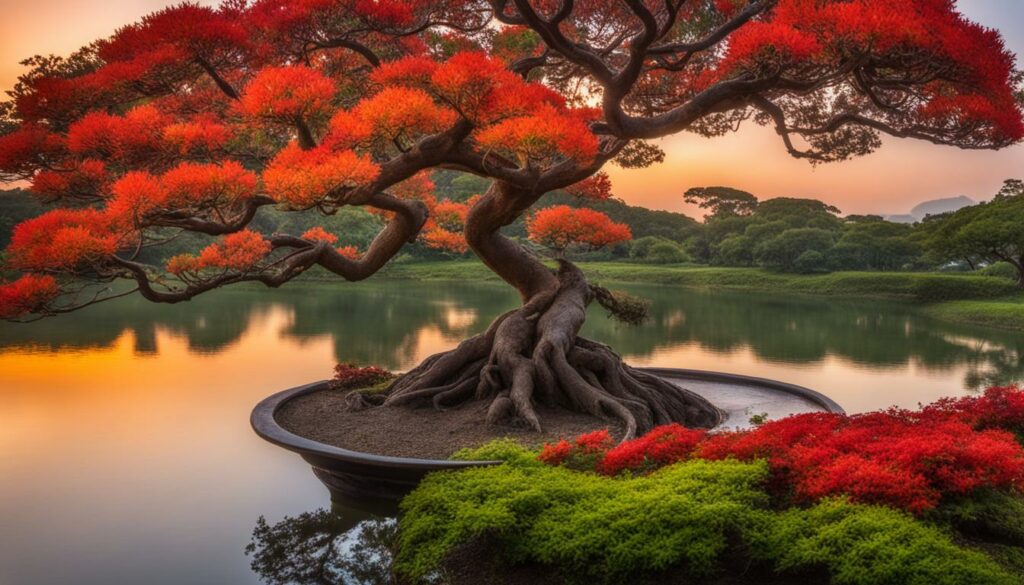
Whether you are new to bonsai or a seasoned enthusiast, the Flame Tree bonsai is a species that is sure to captivate and delight. With its dazzling flowers, vibrant foliage, and tropical origins, this species is a standout choice for any collector.
Selecting a Healthy Flame Tree Bonsai
When selecting a Flame Tree bonsai, it is essential to inspect the tree for signs of good health. A healthy specimen is more likely to survive and thrive in your care, allowing you to enjoy its beauty for years to come. Here are the key factors to consider when selecting a healthy Flame Tree bonsai:
Foliage
Inspect the foliage of the Flame Tree bonsai to ensure that it is lush, vibrant, and free of spotting or discoloration. Leaves should be plump, firm, and not wilted. The presence of brown spots or yellowing leaves may indicate a lack of nutrients or pests, while overly dry leaves may signal inadequate watering.
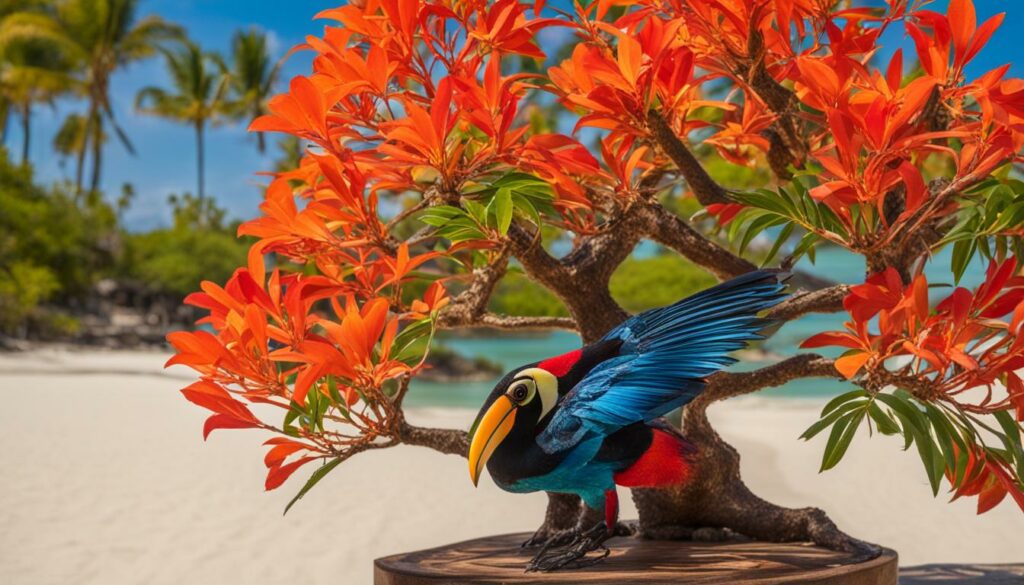
Root System
Examine the root system carefully to ensure that it is healthy. A healthy root system will have a good balance of thick and thin roots, indicating a strong foundation for the bonsai. Avoid trees with mushy or rotting roots, as this may cause tree death.
Trunk and Branches
The trunk and branches are the basic structure of a bonsai tree. Ensure that the trunk is straight and tapering and that branches are balanced and not lopsided. Avoid trees with trunk damage, disease, or insect infestation.
Age
The age of the bonsai tree is also a factor to consider. Older trees, over six years, may have a more established shape but are also significant investments. Younger trees are more affordable but on the other hand require more training as you shape it into the desired style. Determine the age category that fits your budget and experience level, being prepared for the specific care needs, challenges, and rewards of that category.
By carefully evaluating these factors when selecting a Flame Tree bonsai, you can ensure that you bring home a healthy and thriving specimen. Following proper care techniques, you can nurture it into a masterpiece that reflects the vibrant beauty of this tropical bonsai species.
Nurturing and Maintaining Your Flame Tree Bonsai
Now that you have selected a healthy Flame Tree bonsai, it’s time to explore the essential care techniques that will ensure its growth and development.
Watering
It’s important to keep the soil consistently moist without overwatering your Flame Tree bonsai. Check the soil regularly and water thoroughly when the top inch of soil feels dry to the touch. Avoid allowing the soil to dry out completely, as this can damage the roots and affect the health of your bonsai.
Fertilizing
Flame Tree bonsai require regular feeding to maintain their health and vibrant foliage. Use a balanced liquid fertilizer and apply it every two weeks during the growing season, reducing the frequency to once a month during the dormant season.
Pruning
Regular pruning is essential for maintaining the shape and size of your Flame Tree bonsai. Prune back new growth to maintain its overall shape and remove any dead or damaged branches to promote new growth.
Wiring
If you want to shape and train your Flame Tree bonsai into a specific form, wiring can be a helpful technique. Use bonsai wire to gently bend branches into the desired shape, being careful not to damage the bark or branch structure.
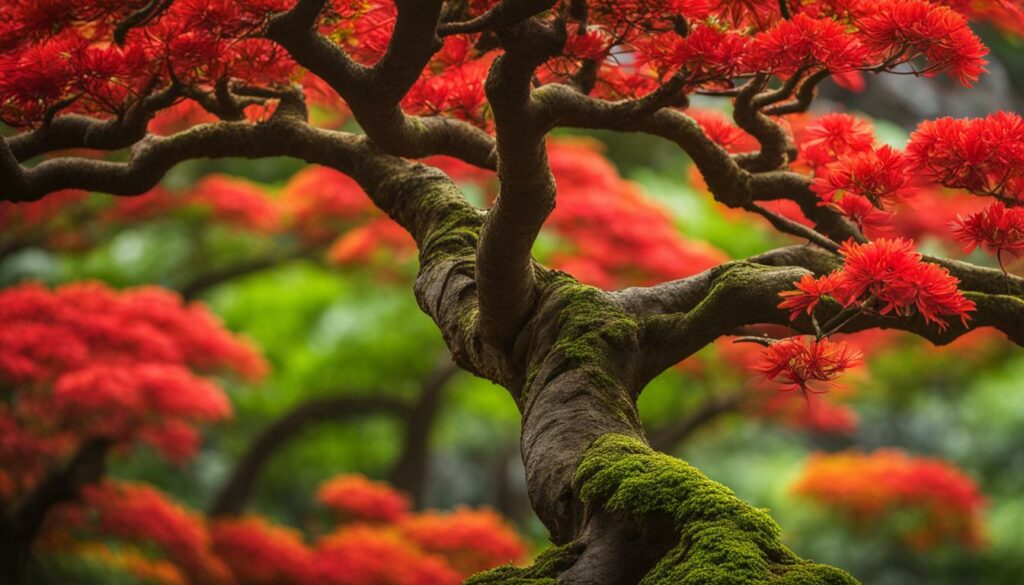
Tip: When wiring your Flame Tree bonsai, keep a close eye on the branch to avoid any wire cutting into the bark. Remove the wire after a few months to prevent any scarring and adjust the angle if necessary.
By following these essential care techniques, your Flame Tree bonsai will thrive and become a stunning masterpiece in your collection. With proper care, it will continue to enhance your space, adding a burst of vibrancy to your surroundings.
Styling and Shaping Your Flame Tree Bonsai
Styling and shaping your Flame Tree bonsai is a gratifying process that allows you to enhance its inherent beauty and uniqueness. Techniques like wiring, pruning, and pinching can help you create a visually appealing masterpiece that elevates the natural characteristics of the Delonix regia species.
Before styling, consider the overall shape you want your bonsai to take. The informal upright style or slanting style are great choices for the Flame Tree bonsai. However, if you prefer a dramatic look, the cascade bonsai style is perfect.
Wiring is an essential part of shaping your bonsai. Use aluminum or copper wire to wrap around branches and bend them into the desired position. Make sure to remove the wire after a few months to prevent it from cutting into the bark.
Pruning involves trimming off unwanted branches and foliage to encourage new growth and maintain the overall shape of your bonsai. Pinching is another technique used to control the growth of your Flame Tree bonsai, giving your masterpiece an aesthetically pleasing look.
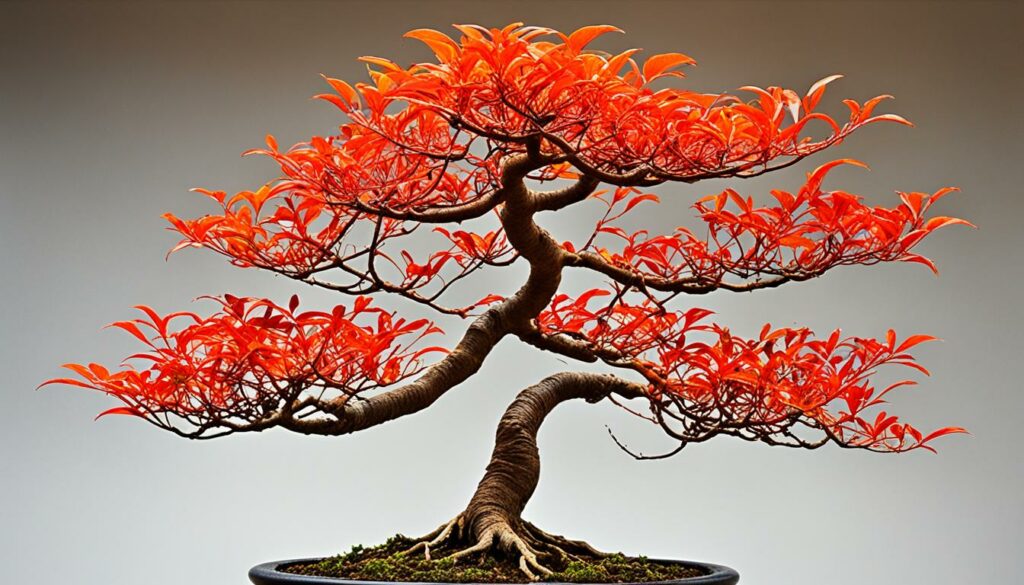
Expert Tip: Avoid excessive pruning and pinching. Always remove one-third of the foliage and branches to prevent stress on the plant.
Bonsai Styling and Shaping Table
| Technique | Description |
|---|---|
| Wiring | Works by wrapping wire around branches and bending them into shape. |
| Pruning | Involves trimming off unwanted branches and foliage to encourage new growth and maintain shape. |
| Pinching | Involves removing new growth with your fingers to control growth and maintain shape. |
Styling and shaping your Flame Tree bonsai is an art that requires time, dedication, and patience. With the right techniques and constant care, your bonsai will transform into a stunning masterpiece that radiates the unique character of the Delonix regia species.
Troubleshooting Common Issues with Flame Tree Bonsai
Even with proper care, your Flame Tree bonsai may encounter some common issues. Don’t worry, most can be remedied with a little effort and attention to detail.
Pests and Diseases
Flame Tree bonsai are susceptible to a variety of pests and diseases, including spider mites, aphids, and root rot. Regularly inspect your bonsai for any signs of infestations or abnormalities, such as yellowing leaves or wilted branches.
If you do identify any problems, there are a variety of remedies available, including organic and chemical treatments. Consult with a local nursery or bonsai expert for advice on the best course of action.
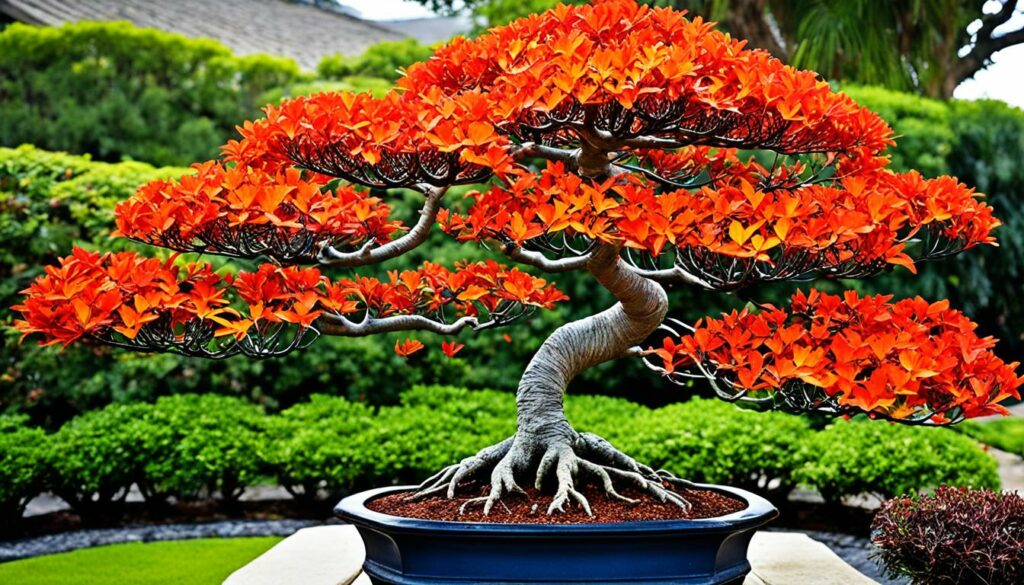
Overwatering and Underwatering
Overwatering or underwatering your Flame Tree bonsai can lead to significant issues, such as root rot or dehydration. Always ensure that your bonsai has proper drainage, and water only when the soil is dry to the touch.
If you’re unsure about watering frequency, consider investing in a moisture meter to take the guesswork out of the equation.
Growth Abnormalities
Occasionally, your Flame Tree bonsai may exhibit growth abnormalities, such as stunted or distorted growth patterns. This can be caused by a variety of factors, including rootbound conditions or improper nutrition.
If you suspect that your bonsai is experiencing growth abnormalities, take steps to address any potential issues, including repotting, adjusting fertilizer levels, or adjusting lighting and temperature conditions.
Conclusion
The Flame Tree bonsai, scientifically known as Delonix regia, is a stunning tropical bonsai species that can add a burst of vibrant color to any bonsai collection. By dedicating proper care and attention to its unique requirements, you can cultivate a captivating masterpiece that reflects the fiery character of this species. Remember to select a healthy specimen and follow essential care techniques, such as watering, fertilizing, pruning and wiring, to ensure its health and artistic growth. Be prepared to troubleshoot common issues like pests, diseases and growth abnormalities, and address them promptly to promote longevity.
Embark on the rewarding journey of bonsai cultivation and explore the captivating beauty of the Flame Tree bonsai!
FAQ
What is a Flame Tree bonsai?
A Flame Tree bonsai is a miniature version of the Delonix regia tree, a tropical species known for its vibrant red or orange flowers and feathery foliage. It is cultivated and trained in a bonsai style, creating a stunning miniature representation of the full-sized tree.
How big do Flame Tree bonsai grow?
The size of a Flame Tree bonsai can vary depending on the age and training it has undergone. Generally, Flame Tree bonsai can reach heights of 1-2 feet and have a spread of 1-2 feet, making them a compact and manageable size for cultivating indoors or on a small patio.
Where can I buy a Flame Tree bonsai?
Flame Tree bonsai can be purchased from nurseries specializing in bonsai trees, both online and in physical locations. Additionally, bonsai enthusiasts and clubs often have sales or exchanges where you may find Flame Tree bonsai for sale.
How often should I water my Flame Tree bonsai?
The watering needs of a Flame Tree bonsai will vary depending on factors like temperature, humidity, and the size of the pot. As a general rule, check the moisture level of the soil regularly and water your bonsai when the top inch of soil feels dry. Avoid overwatering or letting the soil dry out completely.
Does a Flame Tree bonsai require special care compared to other bonsai species?
While every bonsai species has its own unique care requirements, Flame Tree bonsai generally thrive in warm, tropical conditions. They prefer bright indirect sunlight, regular watering, and occasional fertilization during the growing season. It’s always best to research and understand the specific needs of the Flame Tree bonsai to ensure its health and vitality.
Can I display my Flame Tree bonsai indoors?
While Flame Tree bonsai can tolerate indoor conditions for short periods, they are best suited for outdoor cultivation in bright, indirect sunlight. If you choose to display your bonsai indoors, ensure it receives ample sunlight near a window or under grow lights and provide proper humidity levels to mimic its natural tropical environment.
How do I prune my Flame Tree bonsai?
Pruning is an essential technique to maintain the shape and overall health of your Flame Tree bonsai. Begin by studying the natural growth pattern of the tree and carefully remove any dead, damaged, or overcrowded branches. Use sharp bonsai pruning shears and make clean, angled cuts just above leaf nodes. Regular pruning will encourage branching and maintain the desired form of your bonsai.
What diseases and pests should I watch out for with Flame Tree bonsai?
Flame Tree bonsai can be susceptible to pests like aphids and spider mites, as well as diseases such as root rot and leaf spot. Regularly inspect your bonsai for any signs of infestation or illness and take appropriate action immediately. Using organic pest control methods and maintaining good bonsai hygiene will help prevent and address these issues.
